Shaibal S. Mitra, Chair; Doug Wilson, Secretary, Robert Emerson, Rachel Farrell, Paul L’Etoile, Peter Paton, and Scott Tsagarakis
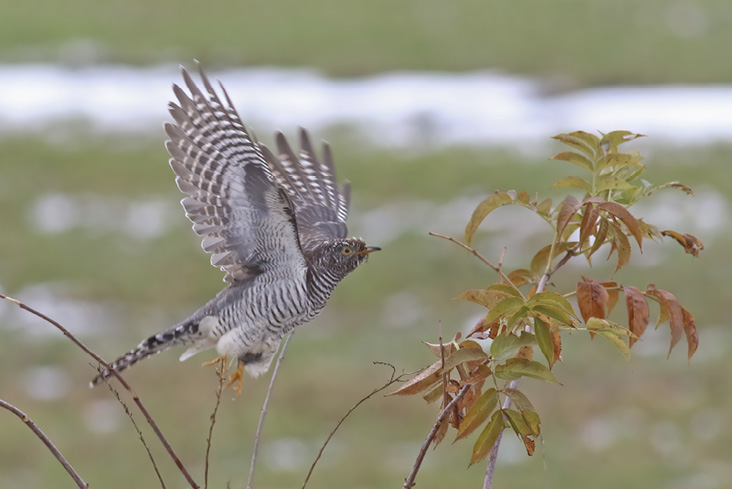
Common Cuckoo. November 1, 2020. Snake Den State Park, Johnston. Photograph by Jeremiah Trimble.
This report describes the Rhode Island Avian Records Committee’s (RIARC) evaluation of 72 records from 2019–2020. These records are grouped by species, with each species entry followed by four numbers in parentheses (a, b, c, d), defined as follows:
a the number of records cited by Howe and Sturtevant (1899).
b the number of records accepted from 1900–2002. This number is derived principally from the Checklist of Rhode Island Birds (Rhode Island Ornithological Club 2002), which represents a synthesis of information from Ferren (in press), Conway (1992), and records accepted by a pre-RIARC committee of reviewers for Field Notes of Rhode Island Birds through 2002 (Raithel 2001, 2002). The symbol “++” represents relatively frequent historical occurrence of the species, which could be replaced with a number pending ongoing research.
c the number of accepted records from 2003–2018, including those published in RIARC’s three previous reports (Mitra et al. 2010, 2021, 2022).
d the number of accepted records from 2019–2020 published in the present report.
The sum of a, b, c, and d represents the total number of verified records in Rhode Island through December 2020.
The present report features numerous highlights, including the first Rhode Island records of Common Cuckoo, Red-necked Stint, Terek Sandpiper, and Gray Kingbird; second state records for Eurasian Collared-Dove and Wood Stork; and second and third state records for Little Stint. Rates of occurrence continue to increase for some species, such as Cackling Goose and Sandhill Crane (which we removed from the Review List, see below), or to remain higher than historical levels, such as Mississippi Kite. In contrast, other species have occurred less frequently in recent years than in the late twentieth century, for example Eared Grebe, Gull-billed Tern, and Western Kingbird.
For each record below, we list the RIARC report number; the vote of the Committee (accept–not accept); the number of individuals; the location; the date(s) of occurrence; and the observer(s), with the following codes: I = initial finder, R = provided a written report, and P = provided photo(s).
Pink-footed Goose (Anser brachyrhynchus) (0, 0, 5, 1); first 2007
2019-19 (7-0): Gardiners Pond, Middletown, Third Beach Restoration Area, Middletown, and Hammersmith Farm, Newport; December 3, 2019, to January 3, 2020; Matt Schenck (I), Barbara Gearhart (R), Paul L’Etoile (R, P), Bob Weaver (R, P).
Discovered at Gardiners Pond, Middletown, on December 3, 2019, this bird was photographed at the nearby Third Beach Restoration Area during the Newport-Westport CBC on December 15. It and the flock it was with were seen to fly north and were refound that day in fields in central Middletown, and what is presumed to be the same bird was later seen at Hammersmith Farm, Newport, on January 2–3, 2020.
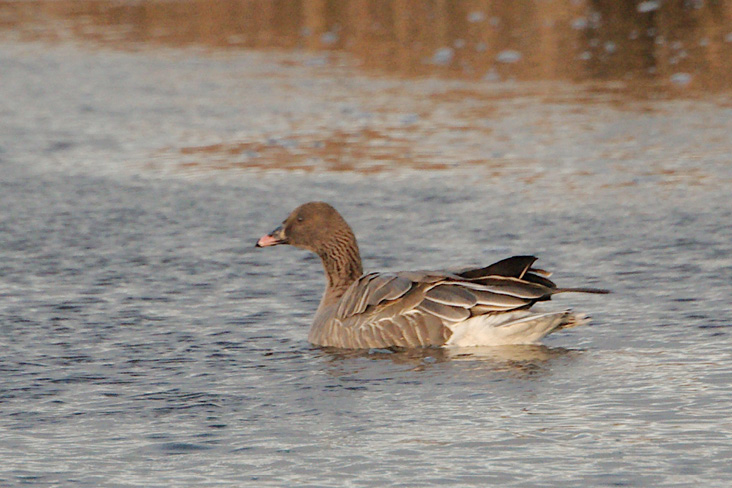
Pink-footed Goose. December 15, 2019. Third Beach Restoration Area, Middletown. Photograph by Paul L’Etoile.
Barnacle Goose (Branta leucopsis) (0, 5, 2, 2); first 1989
2019-02 (7-0): Slocum, North Kingstown; January 29–30, 2019; Carlos Pedro (I, R, P).
2019-04A (7-0): Moonstone Beach Road, South Kingstown; March 17–23, 2019; Dave Mozzoni (I, R, P), multiple other observers.
2019-04B (7-0): Beavertail State Park, Jamestown; March 24, 2019; Bill Thompson (I, R, P).
Based on dates and proximity, 2019-04 A & B are treated as a single record.
†Cackling Goose (Branta hutchinsii) (0, 2, ++, ++); first 1998
The first documented records of Cackling Goose in Rhode Island occurred in 1998, prior to the taxonomic split from Canada Goose in 2003 (Banks et al. 2003). The records from December 1998 in Usquepaug involved an individual of the subspecies minima, which is rare on the East Coast, as well as one report of the now-expected nominate subspecies hutchinsii. Subsequent records remained sparse until the past decade, which probably is a function of birders’ increasing familiarity with Richardson’s Cackling Goose, along with an ongoing increase in the species abundance in the region. In recognition of these major shifts, the Committee agreed, with some reservations, to remove B. h. hutchinsii from the Review List. Given identification difficulties, observers are urged to use caution, to verify multiple field marks specific to Richardson’s Goose (e.g., wing and body shape, frosty dorsal plumage, low contrast between breast and flanks), and to obtain photos whenever possible, before considering an identification confident.
Tufted Duck (Aythya fuligula) (0, 10, 11, 4); first 1991
2019-25 (7-0): Male and female; Green End Pond, Middletown; May 13–15, 2019; Matthew Schenck, (R, P), Louise Ruggeri (R, P), Tim Metcalf (R, P).
2019-26 (7-0): Female; Trustom Pond NWR, South Kingstown; October 16 to November 23, 2019; Bill Ostiguy (P), Shai Mitra (P).
2019-27 (7-0): Male; Easton Pond and Green End Pond, Newport and Middletown; October 19, 2019, to May 10, 2020; Louise Ruggeri (P), Jim O’Neill (P).
2020-02 (7-0): Male; Easton Pond, Newport and Middletown; January 28 to March 13, 2020; Bob Weaver (R, P).
2020-30 (7-0): Male; Trustom Pond NWR, South Kingstown; November 27, 2020, to January 22, 2021; David Mozzoni (P), Bill Thompson (P).
Assuming 2019-27 and 2020-02 were separate individuals, then it is likely that one may have represented the return of record 2019-25, and this conclusion is indicated in the record count above.
Eared Grebe (Podiceps nigricollis) (0, 28, 4, 1); first 1951
2019-18 (7-0): Quonochontaug, Charlestown; December 8, 2019; Matt Schenck (I, R, P), Bill Thompson (P).
The location and oceanfront setting of this record is similar to 2018-31, at Weekapaug Breachway, Westerly, December 23–30, 2018, suggesting it may represent the same individual.
Eurasian Collared-Dove (Streptopelia decaocto) (0, 0, 1, 1); first 2012
2019-10 (7-0): Quonochontaug, Charlestown; June 18, 2019; Curtis Smith (I), Sue Carnahan (I, R, P).
This is the second record for Rhode Island, following one on April 14, 2012, at Matunuck School House Road, Charlestown, near the site of this record. Given the difficulties in distinguishing this species from African Collared-Dove, reservations about the identification were expressed during review, but the record gained the Committee’s support.
Common Cuckoo (Cuculus canorus) (0, 0, 0, 1)
2020-24 (7-0): Snake Den State Park, Johnston; November 1–8, 2020; Al Schenck (I, R, P), Louis Bevier (R), Tim Healey (R, P), Jeremiah Trimble (R, P).
Discovered by Al Schenk, this first state record for Rhode Island is also one of very few in North America away from Alaska. The bird was studied and photographed by hundreds of birders over its weeklong stay, during which time it was often very cooperative as it hunted and consumed large caterpillars. Many excellent photographs and several carefully researched critical analyses aided the Committee in distinguishing this hatching-year Cuculus as a Common Cuckoo, rather than an Oriental Cuckoo, C. optatus. A number of features supportive of the identification of this individual as Common Cuckoo included: whitish undertail coverts with narrow dark bars; underwing lacking a bold white central bar; white spots on the rump (possibly also shown by immature Oriental); distinct barring on the lesser primary coverts on the underwing; and greater number of bars on the outer primaries (Kennerley and Leader 1991). The last of these characteristics is perhaps the most definitive, as the Rhode Island bird showed nine bars on p8 (e.g., in Jeremiah Trimble’s photo), compared to a maximum of seven bars on p8 in Oriental Cuckoo (Lehikoinen and Väisänen 2020).
An unresolved question concerns the origin of this exceptional vagrant: did it travel across North America from East Asia or across the Atlantic Ocean from Europe or Africa?
Chuck-will’s-widow (Antrostomus carolinensis) (0, ++, 5, 2); first 1980
2019–22 (7–0): Tillinghast Management Area, West Greenwich; May 1 to July 8, 2019; multiple observers.
2020–27 (7–0): Tillinghast Management Area, West Greenwich; May 2 to June 16, 2019; multiple observers.
One or two territorial birds have been present at this site in Kent County since 2016. Other recent stations for this inconspicuous species have been widely spaced in Washington and Newport counties, implying that more intensive and extensive nocturnal surveys might reveal additional potential breeding sites in Rhode Island’s pine-oak forests.
Rufous Hummingbird (Selasphorus rufus) (0, 1, 5, 1)
2019-20 (7-0): Little Compton; November 9 to December 23, 2019; Geoff Dennis (I, R, P).
This identification to species level was easier than usual, as the bird was a rufous-backed male. Documentation was excellent, with beautiful photos by Geoff Dennis, Rhode Island’s foremost expert on hummingbird identification.
Rufous/Allen’s Hummingbird (Selasphorus rufus/sasin) (0, 4, 15, 1)
2019-21 (7-0): North Kingstown; November 9 to December 23, 2019; Geoff Dennis (I, R, P).
†Sandhill Crane (Antigone canadensis) (1, 14, 13, 5)
2020-04 (7-0): North Kingstown; March 18, 2020; Jeff Hall (R).
2020-20 (7-0): Jamestown; April 11, 2020; Chris Powell (I, R, P).
2020-21 (7-0): Great Swamp Management Area; April 11–12, 2020; Carlos Pedro (P), Alexander Patterson (P).
2020-22 (7-0): Eight Rod Farm WMA, Tiverton; May 13, 2020; Liam Corcoran (P).
2020-38 (7-0): Block Island; May 13, 2020; Stephen Record (R, P).
With occurrences this century now outnumbering the total of all prior records, the Committee voted to remove this large and readily identifiable species from the Review List.
Wilson’s Plover (Charadrius wilsonia) (0, 10, 1, 2); first 1954
2019-06 (7-0): Charlestown Breachway, Charlestown; May 4, 2019; Sam Miller (I), Paul L’Etoile (P), Carlos Pedro (P), Don Heitzmann (P).
2020-03 (7-0): Scarborough Beach, Narragansett; March 18–25, 2020; Jessica Kiamco (I, R, P), Sue Palmer (R, P), multiple photographers.
Ruff (Calidris pugnax) (0, ++, 7, 2); first 1900
2020-11 (7-0): Male; Charlestown Breachway, Charlestown; July 8, 2020; Don Whiteman (I, R), Patrick Felker (P).
2020-23 (7-0): Female; Winnapaug Pond; July 20, 2020; Liam Corcoran (I, P).
Like Purple Gallinule, this species has occurred in Rhode Island rarely but almost steadily over more than a century, without any pronounced changes in status. This consistency is in contrast to most species regarded as rare in any period, which have tended to exhibit marked shifts in abundance over a historical record now approaching two centuries.
Red-necked Stint (Calidris ruficollis) (0, 0, 0, 1)
2020-09 (7-0): Napatree Point, Westerly; July 5–8, 2020; Bill Thompson (I, R, P).
Rhode Island’s long-anticipated first state record was found by Bill Thompson amid a dizzying series of shorebird mega-rarities along the western South County shore from late June through late July 2020.
Little Stint (Calidris minuta) (0, 0, 1, 2); first 2012
2020-10 (7-0): Charlestown Breachway, Charlestown; July 6–9, 2020; Tim Metcalf (I, R), Sue Palmer (P), Barbara Gearhart (R).
2020-14 (7-0): Charlestown Breachway, Charlestown; July 29 to August 9, 2020; Scott Tsagarakis (I, R), Patrick Felker (R, P).
Plumage differences based on photographic evidence suggest that these reports represent two different individuals.
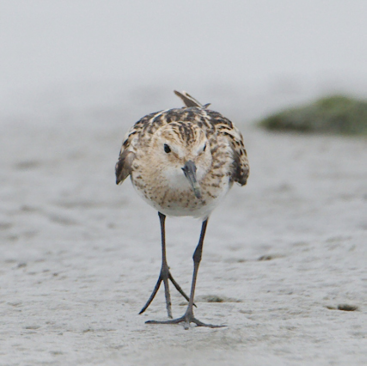
Little Stint, July 30, 2020. Charlestown Breachway, Charlestown. Photograph by Paul L’Etoile.
Long-billed Dowitcher (Limnodromus scolopaceus) (1, ++, 6, 3)
2019-23 (6-1): Green End Pond, Middletown; October 19–22, 2019; Louise Ruggeri (I, R, P).
2020-28 (7-0): Easton Pond, Newport; September 15–19, 2020; Louise Ruggeri (P), Tim Metcalf (P), Sue Palmer (P).
2020-29 (6-1): Perry Pond, Charlestown; November 16–21, 2020; Sue Palmer (I, R, P), Christopher Veale (P), Tim Metcalf (P).
This difficult-to-identify species is infrequently detected in Rhode Island, and all reports deserve continued careful scrutiny and documentation.
Terek Sandpiper (Xenus cinereus) (0, 0, 0, 1)
2020-08 (7-0): Napatree Point, Westerly; June 28–30, 2020; Jan St. Jean (I, R, P).
The third record of this species for the Atlantic coast of North America, this astonishing discovery by Jan St. Jean was the start of an unprecedented series of Palearctic shorebirds detected between Napatree and Charlestown Breachway in 2020. By the end of July, this short stretch of coast had also accrued records of two Ruffs, two Little Stints, and Rhode Island’s first Red-necked Stint.
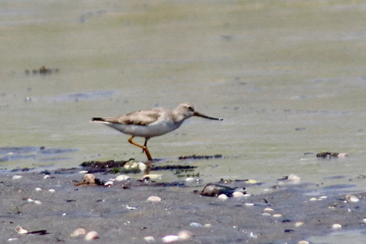
Terek Sandpiper. June 28, 2020. Napatree Point, Westerly. Photograph by Carlos Pedro.
Long-tailed Jaeger (Stercorarius longicaudus) (0, ++, 2, 1); first 1952
2020-37 (7-0): Two juveniles; Block Canyon; September 8, 2020; Carlos Pedro (R, P), Scott Tsagarakis (R).
Thick-billed Murre (Uria lomvia) (4, ++, 8, 1)
2020-26 (7-0): Westerly train station; January 19, 2020.
This bird was detected alive in a parking lot and photographed by an anonymous user of eBird.
“Thayer’s” Iceland Gull (Larus glaucoides thayeri) (0, 7, 1, 1); first 1965
2020-35 (7-0): Misquamicut State Beach, Westerly; Scott Tsagarakis (I, R), Sue Palmer (R, P).
This bird is always difficult to identify, but this well-documented record with excellent photographs was discussed at length by eBird reviewers and on online gull-identification forums, and the consensus was that “Kumlien’s” Iceland Gull could be excluded with confidence.
Sooty Tern (Onychoprion fuscatus) (2, 10, 1, 2)
2020-15 (7-0): Seekonk River, Providence; August 4, 2020; Greg Nemes (I, R), Alan Kneidel (R), Emily Renaud (R).
2020-16 (7-0): Charlestown Breachway, Charlestown; August 5, 2020; Dan Finizia (I, R, P), Sue Talbot (I, R, P), Doug Wilson (I, R, P).
A quintessential hurricane waif, Sooty Tern is one of the few vagrant species that has occurred throughout Rhode Island’s ornithological record from the nineteenth century to the present following tropical storms. These two records occurred after Tropical Storm Isaias passed through the region, displacing Sooty Terns, Band-rumped Storm-Petrels, and other seabirds to other parts of the Northeast.
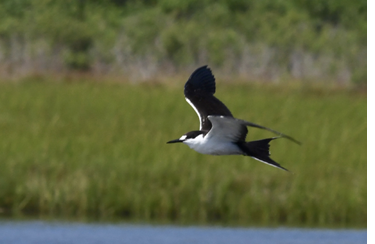
Sooty Tern. August 5, 2020. Charlestown Breachway, Charlestown. Photograph by Dan Finizia.
Gull-billed Tern (Gelochelidon nilotica) (0, 29, 1, 2); first 1944
2019-07 (7–0): Sachuest Point NWR; September 11, 2019; Rey Larsen (I, R, P).
2020-13 (7-0): Charlestown Breachway, Charlestown; June 20, 2020; Alan Kneidel (I, R, P), Greg Nemes (R, P).
Arctic Tern (Sterna paradisaea) (0, 13, 1, 1); first 1928
2020-12 (7-0): Napatree Point, Westerly; July 19, 2020; Alan Kneidel (I, R, P).
The date, location, and age (first summer) of this Arctic Tern align with the typical occurrence pattern of this species south of its breeding areas in the Gulf of Maine: nonbreeders staging briefly at dynamic ocean inlets from late May through mid-July (Mitra 2009).
Pacific Loon (Gavia pacifica) (0, ++, 14, 4); first 1941.
2019-03 (7-0): Salty Brine Beach, Narragansett; January 12, 2019; Tim Metcalf (R, P).
2019-28 (7-0): Watch Hill, Westerly; December 2, 2019; Sue Palmer (R, P), Jan St. Jean (I).
2019-29 (7-0): Charlestown Breachway; December 21, 2019; Patrick Felker (R, P).
2020-39 (7-0): Watch Hill, Westerly; November 12–18, 2020; Jan St. Jean (I), Tim Metcalf (P), Dan Finizia (P).
Rhode Island has produced an exceptional number of records of this rare species. These four were recorded at three widely spaced sites along the South County shore, in contrast to the concentration of records from Block Island documented earlier this century.
Wood Stork (Mycteria americana) (1, 0, 0, 1); first 1896
2019-09 (7-0): Juvenile; Block Island; November 3, 2019; Clara Cooper-Mullin (I, R), Liam Corcoran (I, P).
This second record for Rhode Island, 123 years after the first record, occurred with several other records in the region in 2019: an injured bird in Massachusetts on November 3; an immature at Cape May, New Jersey, November 16–20; and an immature near Scranton, Pennsylvania, on September 25.
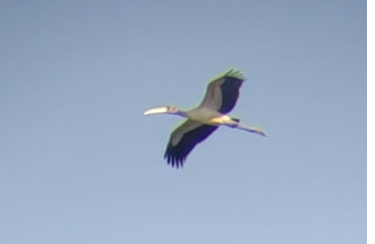
Wood Stork. November 3, 2019. Block Island. Photograph by Liam Corcoran.
Magnificent Frigatebird (Fregata magnificens) (0, 10, 3, 2); first 1932
2020-06 (7-0): Juvenile; Beavertail Point, Jamestown; June 10, 2020; Sherri Roberts (I, R, P).
2020-33 (7-0): Adult female; Breakwater Village, Narragansett; December 28, 2020; Vincent Zompa (I, R), Tim Metcalf (P).
American White Pelican (Pelecanus erythrorhynchos) (0, 8, 8, 1); first 1946
2020-01 (7-0): Two; Nonquit Pond, Tiverton; January 17–19, 2020; Mark Pagliarini (I, R), Sue Palmer (P), Allen Schenck (P).
All but three Rhode Island records have occurred since 1994, but the rate of occurrence remains less than annual.
Brown Pelican (Pelecanus occidentalis) (0, 14, 9, 2); first 1921
2019-01 (7-0): Galilee Harbor, Naragansett; January 4–7, 2019; Michael Macleod (I, R), Bryan Glemboski (R), Carlos Pedro (P).
2019-08 (7-0): Block Island Sound; September 22, 2019; Doug Wilson (I, R).
Brown Pelicans remain rare in Rhode Island. Surprisingly, most records do not occur from June to August, when the species is regularly detected along the ocean coast of nearby Long Island, New York.

Brown Pelican. January 4, 2019. Galilee Harbor, Narragansett. Photograph by Paul L’Etoile.
White-faced Ibis (Plegadis chihi) (0, 2, 8, 2); first 1998
2019-16 (7-0): Marsh Meadow, Jamestown; April 17, 2019; Tim Metcalf (I, R, P).
2019-17 (7-0): Newport; April 24–27, 2019; Peter Capobianco (I, R, P).
Golden Eagle (Aquila chrysaetos) (5, ++, 5, 2)
2020-25 (7-0): Westerly; November 23–24, 2020; Bob Madison (I), Barbara Seith (P), Dave Prigmore (R), Ed Hughes (P).
2020-43 (7-0): Trustom Pond NWR, South Kingstown; November 24, 2020; Ed Hughes (I, P), Jan St. Jean (I).
Photos show that these records from November 24, 2020, involved different individuals.
Mississippi Kite (Ictinia mississippiensis) (0, 6, 8, 5); first 1986
2019-12 (7-0): Great Swamp WMA, South Kingstown; May 21 to June 2, 2019; Jim Feeley (I, R, P), Sam Miller (I, R, P).
2019-13 (7-0): East Greenwich; May 22–26, 2019; Tom Younkin (I, R, P).
2019-14 (7-0): Successful breeding; Deer Run Road, Richmond; May 25 to August 25, 2019; Tim Metcalf (R, P), Sue Palmer (R, P).
2019-15 (7-0): Wakefield, South Kingstown; May 26, 2019; James Restivo (I, R, P).
2020-07 (7-0): Nest-building; Richmond; May 3 to June 7, 2020; Tim Metcalf (R, P).
This species continues to expand its range in the Northeast, including Rhode Island, and was documented nesting successfully in Richmond in 2019.
Ash-throated Flycatcher (Myiarchus cinerascens) (0, 6, 5, 1); first 1960
2019-32 (7-0): Napatree Point, Westerly; November 11, 2019; Barbara Gearhart (I, R).
Veteran observer Barbara Gearhart’s candid description convincingly rules out Great Crested Flycatcher and other species of non-Myiarchus flycatchers. The observation was brief and did not allow for careful study of the tail pattern or photos. Hence, other species of pale-breasted Myiarchus were not excluded with certainty, but both the description and the context were consistent with Ash-throated Flycatcher, leading the Committee to support this record unanimously.
Western Kingbird (Tyrannus verticalis) (0, ++, 7, 2); first 1913
2019-11 (7-0): St. Andrews Farm, Barrington; November 17 to December 3, 2019; Ray Marr (I), multiple photographers.
2020-44 (7-0): Block Island; December 14, 2020; Michael McBrien (I, R, P).
A rare but regular migrant in the coastal Northeast, this western species has been detected less than once per year in Rhode Island in recent decades.
Gray Kingbird (Tyrannus dominicensis) (0, 0, 0, 1)
2020-19 (7-0): Goosewing Beach, Little Compton; June 16, 2020; Geoff Dennis (I, R, P).
Geoff Dennis’s careful attention to this location in Little Compton yielded yet another mega-rarity: Rhode Island’s long-anticipated first Gray Kingbird. As is typical among vagrant Gray Kingbirds, this bird vanished soon after discovery and was not seen again.
Scissor-tailed Flycatcher (Tyrannus forficatus) (0, 3, 1, 1); first 1965
2019-30 (7-0): Trustom Pond NWR, South Kingstown; May 3, 2019; Dominick Pacelli (I, P)
Vermilion Flycatcher (Pyrocephalus rubinus) (0, 1, 0, 0); 1996
Photos of an adult male Vermilion Flycatcher on social media raised hopes of Rhode Island’s second record, but efforts to obtain details were not successful. Therefore, this record could not be verified by the Committee.
Cave Swallow (Petrochelidon fulva) (0, 2, 13, 3); first 1999
2020-05 (7-0): Trustom Pond NWR, South Kingstown; May 9, 2020; Bill Thompson (I, R, P).
2020-41 (7-0): Two; Napatree Point and Watch Hill, Westerly; November 18, 2020; Dan Finizia (I, R), Sue Talbot (I, R), Tom Younkin (I, R).
2020-42 (7-0): Two; Scarborough Beach, Narragansett; November 18, 2020; Carlos Pedro et al.
All reports are from sites where Cave Swallows have previously been documented. The two records on November 18, 2020, in Narragansett and Watch Hill echoed Rhode Island’s first records from November 7, 1999, in the same two areas. November on Rhode Island’s outer coast has been where this species typically has been detected in the region, so the May 9, 2020, record from Trustom Pond NWR is remarkable.
Varied Thrush (Ixoreus naevius) (0, 2, 1, 1); first 1966
2020-31 (7-0): Chepachet; December 17, 2020, to February 15, 2021.
Several observers documented this record with photos on eBird, but it is not clear who initially found this individual.
Hoary Redpoll (Acanthis hornemanni) (0, 11, 2, 1); first 1944
2020-36 (7-0): Lonsdale Marsh; December 11, 2020, to January 27, 2021; Carlos Pedro (P).
Yellow-headed Blackbird (Xanthocephalus xanthocephalus) (0, ++, 8, 2); first 1919
2020-18 (7-0): Little Compton; February 3 to March 21, 2020; Bob Emerson (I, R, P).
2020-40 (7-0): Cumberland; August 8, 2020; Deborah Vine-Smith (P).
These reports illustrate two migration strategies this species exhibits in the Northeast: individuals detected briefly in late summer and early fall and individuals that remain for weeks at feeding stations from late fall to early spring. There have been 10 Rhode Island records since 2002.
Black-throated Gray Warbler (Setophaga nigrescens) (0, 4, 0, 1); first 1921
2020-34 (7-0): Jamestown; September 21, 2020; Candace Powell (I, R, P).
Rhode Island’s first Black-throated Gray Warbler since 1979 briefly visited the Jamestown yard of Candace and Christopher Powell, where Candace was able to document this record with photos and describe other diagnostic features in a definitive written report.
Painted Bunting (Passerina ciris) (1, 8, 4, 1); first 1953
2020-32 (7-0): Watch Hill, Westerly; December 27–28, 2020; Glenn Williams (I), Andrew Dasinger (I), Sue Palmer (P).
Glenn Williams and Andrew Dasinger have covered the area north of Watch Hill Village on the Napatree Christmas Bird Count since its inception in December 2002 and, doing so, discovered a series of rarities including Lark Sparrow, Western Tanager, and now Painted Bunting. This green-plumaged bird was probably an immature rather than an adult female, like one at nearby Montauk, New York, on December 18–19, 2020, and no fewer than seven in New York City and Long Island, New York, during December 2019 (Futuyma 2020; Futuyma 2021).
Literature Cited
- Banks, R. C., C. Cicero, J. L. Dunn, A. W. Kratter, P. C. Rasmussen, J. V. Remsen Jr., J. D. Rising, and D. F. Stotz. 2003. Forty-Fifth Supplement to the American Ornithologists’ Union Check-List of North American Birds. The Auk 121 (3):985–995.
- D’Anna, W., G. Chapin, T. W. Burke, A. Guthrie, J. Pawlicki, D. Gochfeld, P. Lindsay, and D. Rogers. 2018. Report of the New York State Avian Records Committee for 2014. The Kingbird 68 (4):258–279.
- Futuyma, D. J. 2020. Region 10—Marine. The Kingbird 70 (2):186–198.
- Futuyma, D. J. 2021. Region 10—Marine. The Kingbird 71 (2):192–206.
- Howe, R. H. and E. Sturtevant. 1899. The Birds of Rhode Island. Privately printed. 111 pp.
- Kennerley, P. R. and P. J. Leader. 1991. Separation of Cuckoo and Oriental Cuckoo. Dutch Birding 13 (4):143–145.
- Lehikoinen, P. and Väisänen, R. 2020. Identification of Oriental Cuckoo and Common Cuckoo based on primary pattern. Dutch Birding 42:229–247.
- Mitra, S. S. 2009. Regular inshore occurrence of non-breeding Arctic Terns (Sterna paradisaea) during summer on Long Island, New York. The Kingbird 59 (1):2–11.
- Mitra, S. S., D. Wilson, R. Emerson, R. Farrell, R. Ferren, C. Raithel, and S. Tsagarakis. 2010. First Report of the Rhode Island Avian Records Committee. Bird Observer 38 (5):275–283.
- Mitra, S. S., D. Wilson, R. Emerson, R. Farrell, R. Ferren, P. L’Etoile, P. Paton, C. Raithel, and S. Tsagarakis. 2021. Second Report of the Rhode Island Avian Records Committee. Bird Observer 49 (1):29–53.
- Mitra, S. S., D. Wilson, R. Emerson, R. Farrell, P. L’Etoile, P. Paton, and S. Tsagarakis. 2022. Third Report of the Rhode Island Avian Records Committee. Bird Observer 50 (4):251–273.
- Raithel, C. J. 2001. 1999 Report of the Rhode Island Rare Bird Committee. Field Notes of Rhode Island Birds 382:19–21.
- Raithel, C. J. 2002. Report of the Rare Bird Committee. Field Notes of Rhode Island Birds 396:24–26.
- Rhode Island Ornithological Club. 2002. Checklist of Rhode Island Birds.
